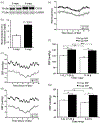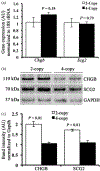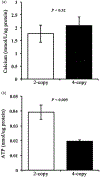Mice overexpressing chromogranin A display hypergranulogenic adrenal glands with attenuated ATP levels contributing to the hypertensive phenotype
- PMID: 29389743
- PMCID: PMC6462411
- DOI: 10.1097/HJH.0000000000001678
Mice overexpressing chromogranin A display hypergranulogenic adrenal glands with attenuated ATP levels contributing to the hypertensive phenotype
Abstract
Objective: Elevated circulating chromogranin A (CHGA) is observed in human hypertension. CHGA is critical for granulogenesis and exocytosis of catecholamine stores from secretory large dense core vesicles (LDCV). This study aims to understand the morphological, molecular and phenotypic changes because of excess CHGA and the mechanistic link eventuating in hyper-adrenergic hypertension.
Methods: Blood pressure and heart rate was monitored in mouse models expressing normal and elevated level of CHGA by telemetry. Catecholamine and oxidative stress radicals were measured. Adrenal ultrastructure, LDCV content and mitochondrial abundance were compared and respiration analyzed by Seahorse assay. Effect of CHGA dosage on adrenal ATP content, electron transport chain components and uncoupling protein 2 (UCP-2) were compared in vivo and in vitro.
Results: Mice with excess-CHGA displayed hypertensive phenotype, higher heart rate and increased sympathetic tone. They had elevated plasma catecholamine and adrenal ROS levels. Excess-CHGA caused an increase in size and abundance of LDCV and adrenal mitochondria. Nonetheless, they had attenuated levels of ATP. Isolated adrenal mitochondria from mice with elevated CHGA showed higher maximal respiration rates in the presence of protonophore, which uncouples oxidative phosphorylation. Elevated CHGA resulted in overexpression of UCP2 and diminished ATP. In vitro in chromaffin cells overexpressing CHGA, concomitant increase in UCP2 protein and decreased ATP was detected.
Conclusion: Elevated CHGA expression resulted in underlying bioenergetic dysfunction in ATP production despite higher mitochondrial mass. The outcome was unregulated negative feedback of LDCV exocytosis and secretion, resulting in elevated levels of circulating catecholamine and consequently the hypertensive phenotype.
Conflict of interest statement
Conflicts of interest
There are no conflicts of interest.
Figures








Similar articles
-
Effects of chromogranin A deficiency and excess in vivo: biphasic blood pressure and catecholamine responses.J Hypertens. 2010 Apr;28(4):817-25. doi: 10.1097/HJH.0b013e328336ed3e. J Hypertens. 2010. PMID: 20139771 Free PMC article.
-
Urocortin 2 lowers blood pressure and reduces plasma catecholamine levels in mice with hyperadrenergic activity.Endocrinology. 2010 Oct;151(10):4820-9. doi: 10.1210/en.2009-1454. Epub 2010 Jul 28. Endocrinology. 2010. PMID: 20668031 Free PMC article.
-
Impact of Chromogranin A deficiency on catecholamine storage, catecholamine granule morphology and chromaffin cell energy metabolism in vivo.Cell Tissue Res. 2016 Mar;363(3):693-712. doi: 10.1007/s00441-015-2316-3. Epub 2015 Nov 16. Cell Tissue Res. 2016. PMID: 26572539 Free PMC article.
-
Chromogranin A: a surprising link between granule biogenesis and hypertension.J Clin Invest. 2005 Jul;115(7):1711-3. doi: 10.1172/JCI25706. J Clin Invest. 2005. PMID: 16007250 Free PMC article. Review.
-
Chromogranin A: a novel factor acting at the cross road between the neuroendocrine and the cardiovascular systems.J Hypertens. 2011 Mar;29(3):409-14. doi: 10.1097/HJH.0b013e328341a429. J Hypertens. 2011. PMID: 21178786 Review.
Cited by
-
Genipin relieves diabetic retinopathy by down-regulation of advanced glycation end products via the mitochondrial metabolism related signaling pathway.World J Diabetes. 2023 Sep 15;14(9):1349-1368. doi: 10.4239/wjd.v14.i9.1349. World J Diabetes. 2023. PMID: 37771331 Free PMC article.
References
Publication types
MeSH terms
Substances
Grants and funding
LinkOut - more resources
Full Text Sources
Other Literature Sources
Medical
Molecular Biology Databases
Research Materials
Miscellaneous

